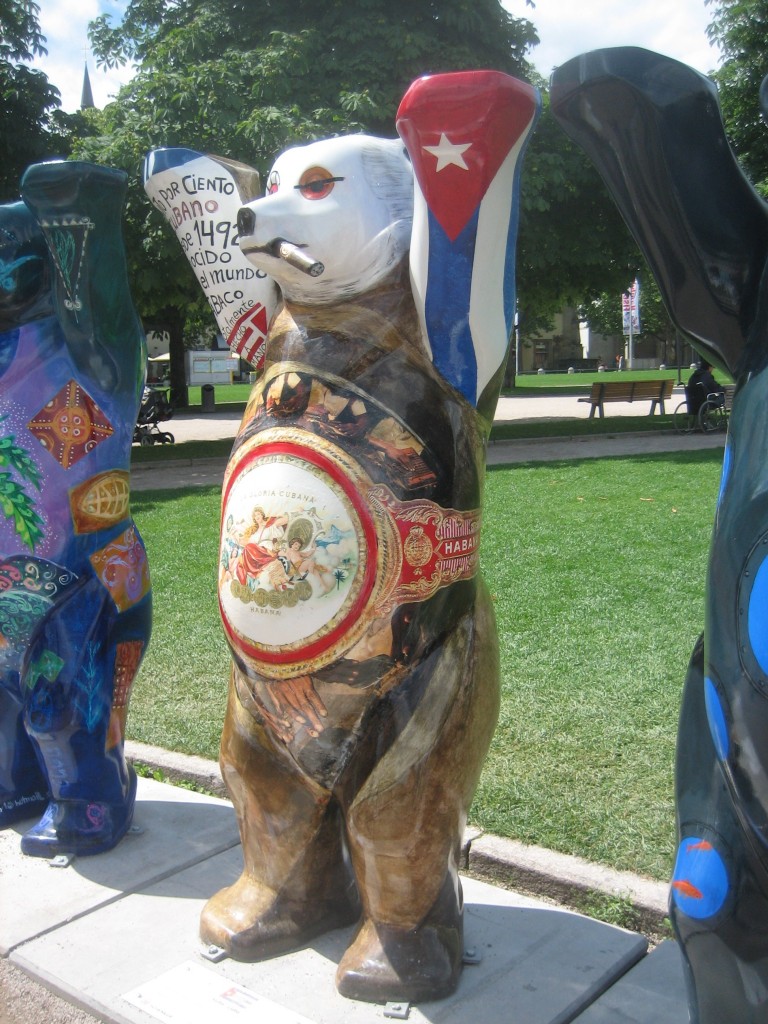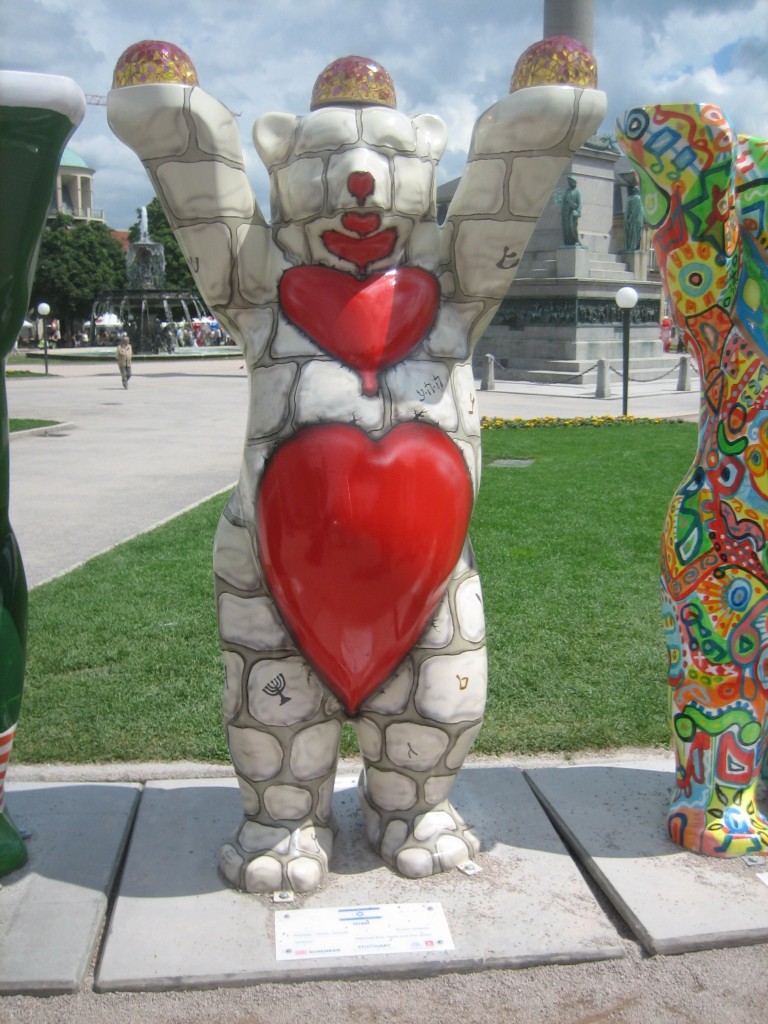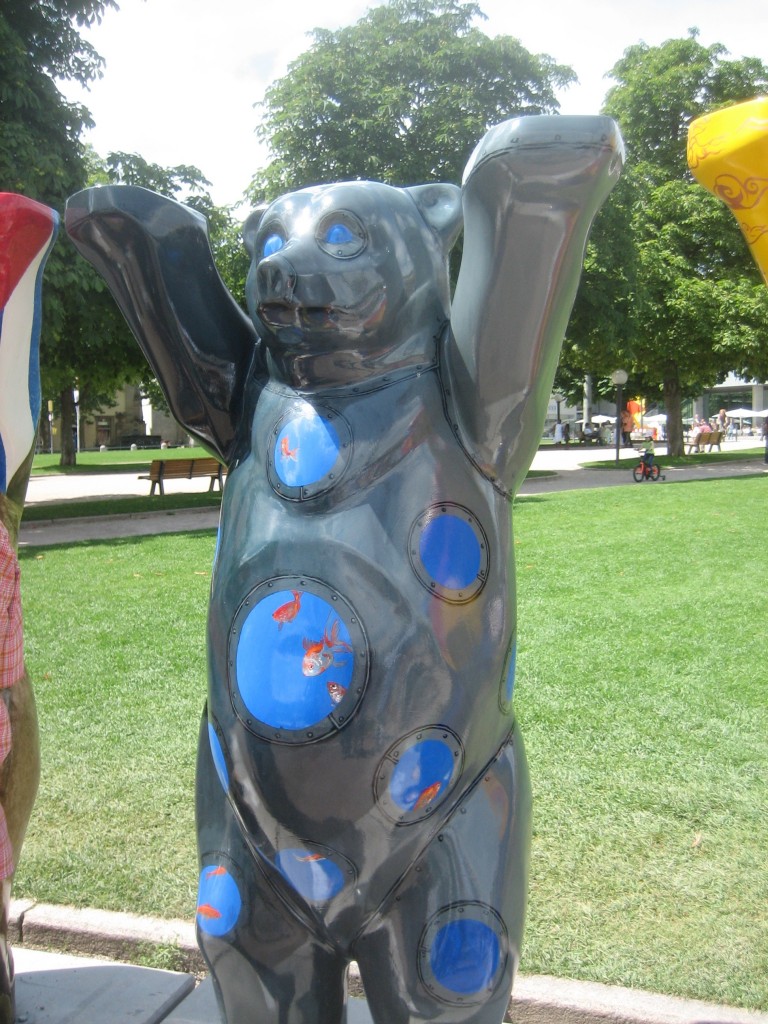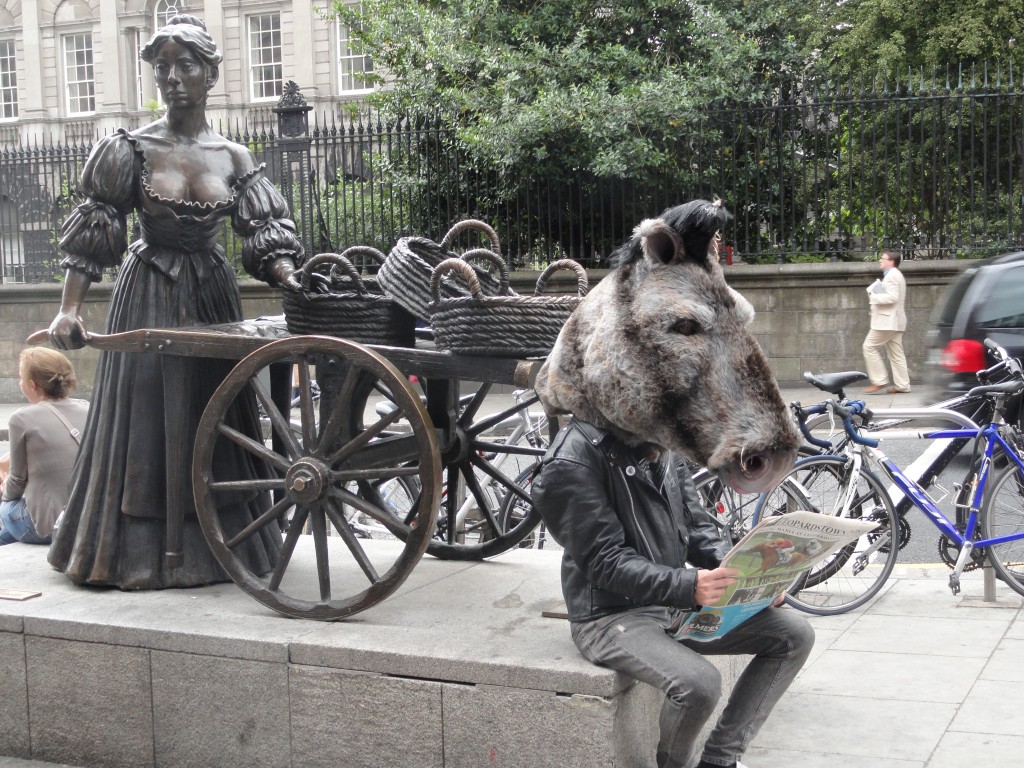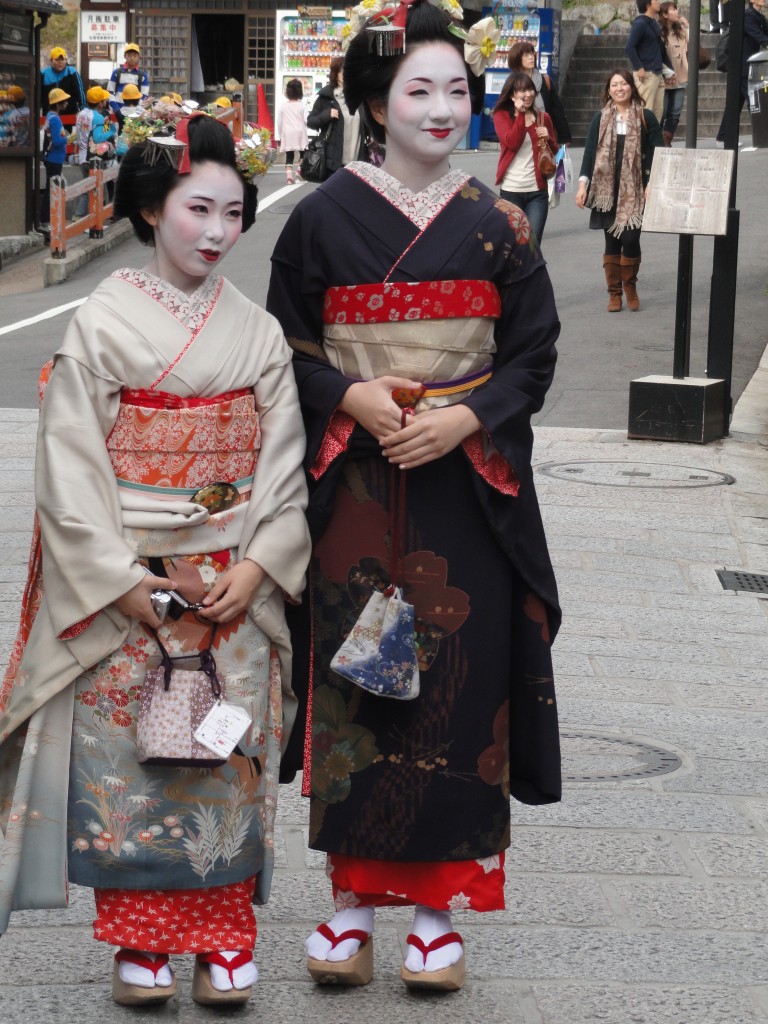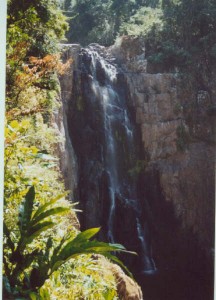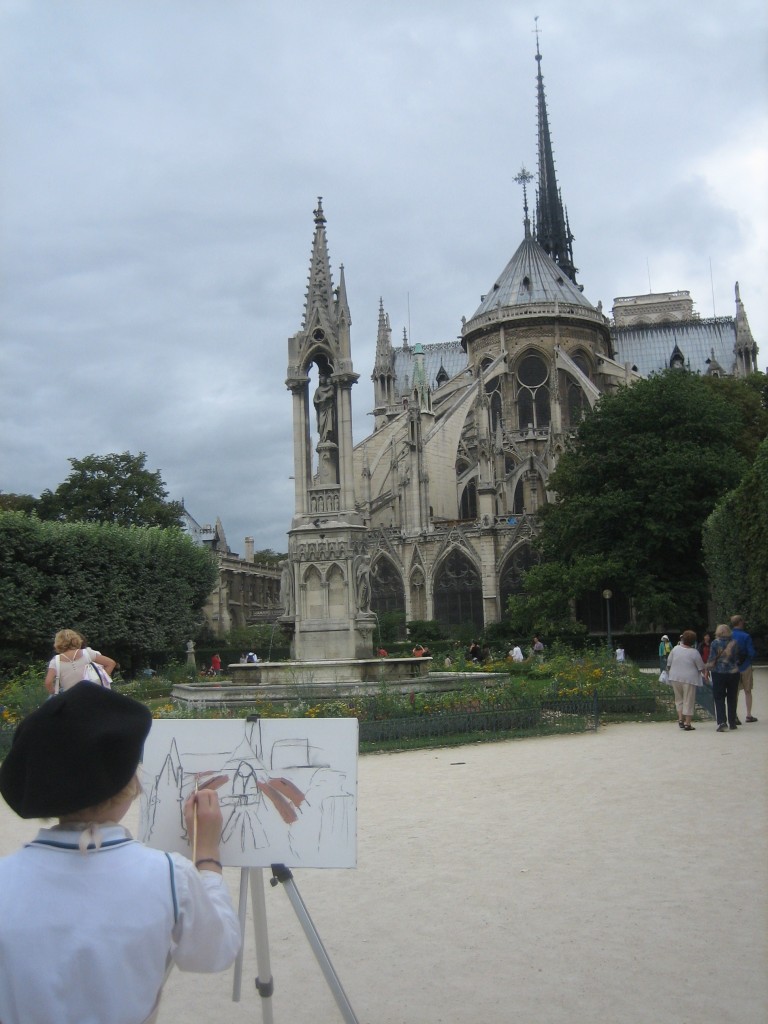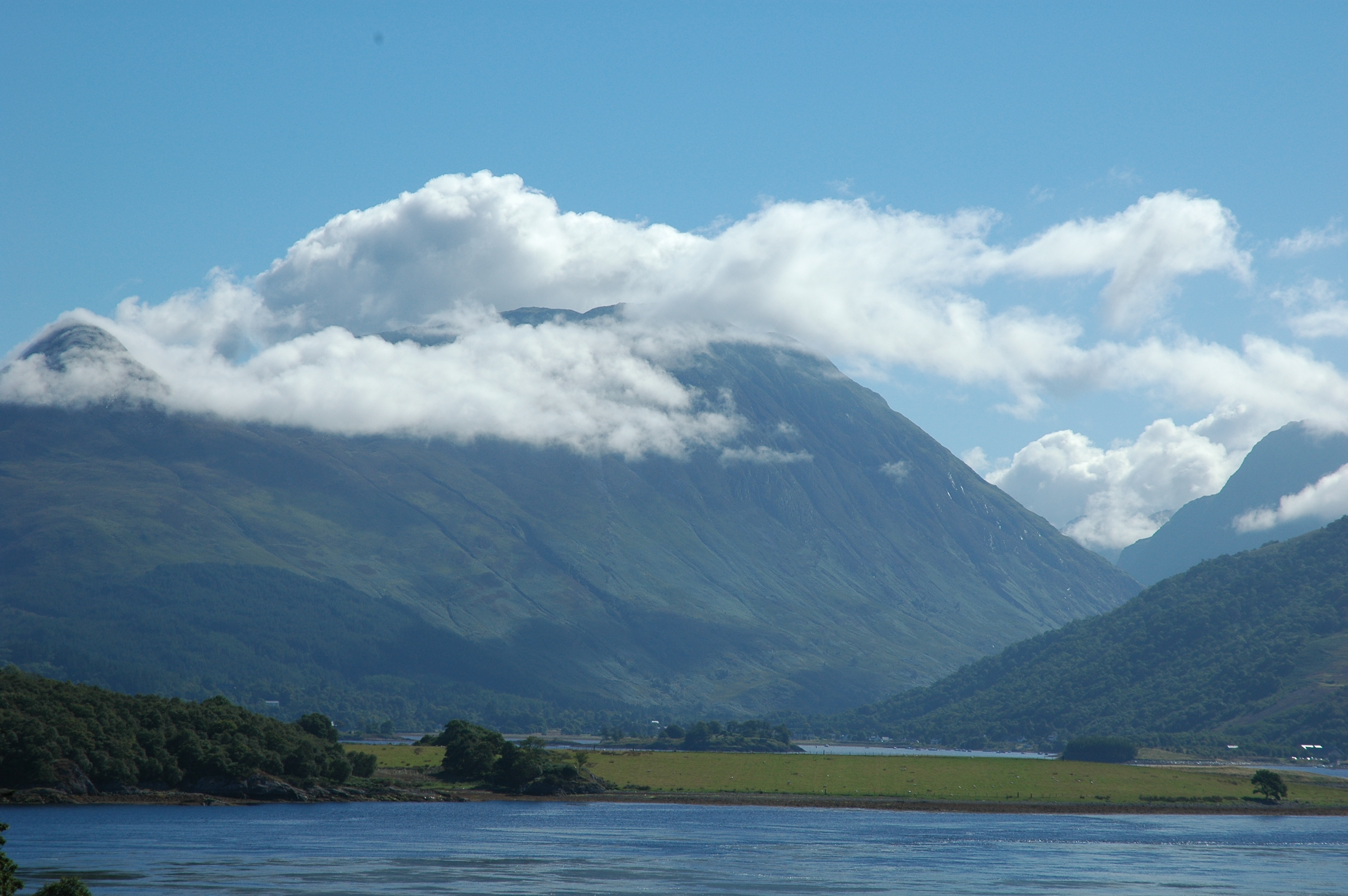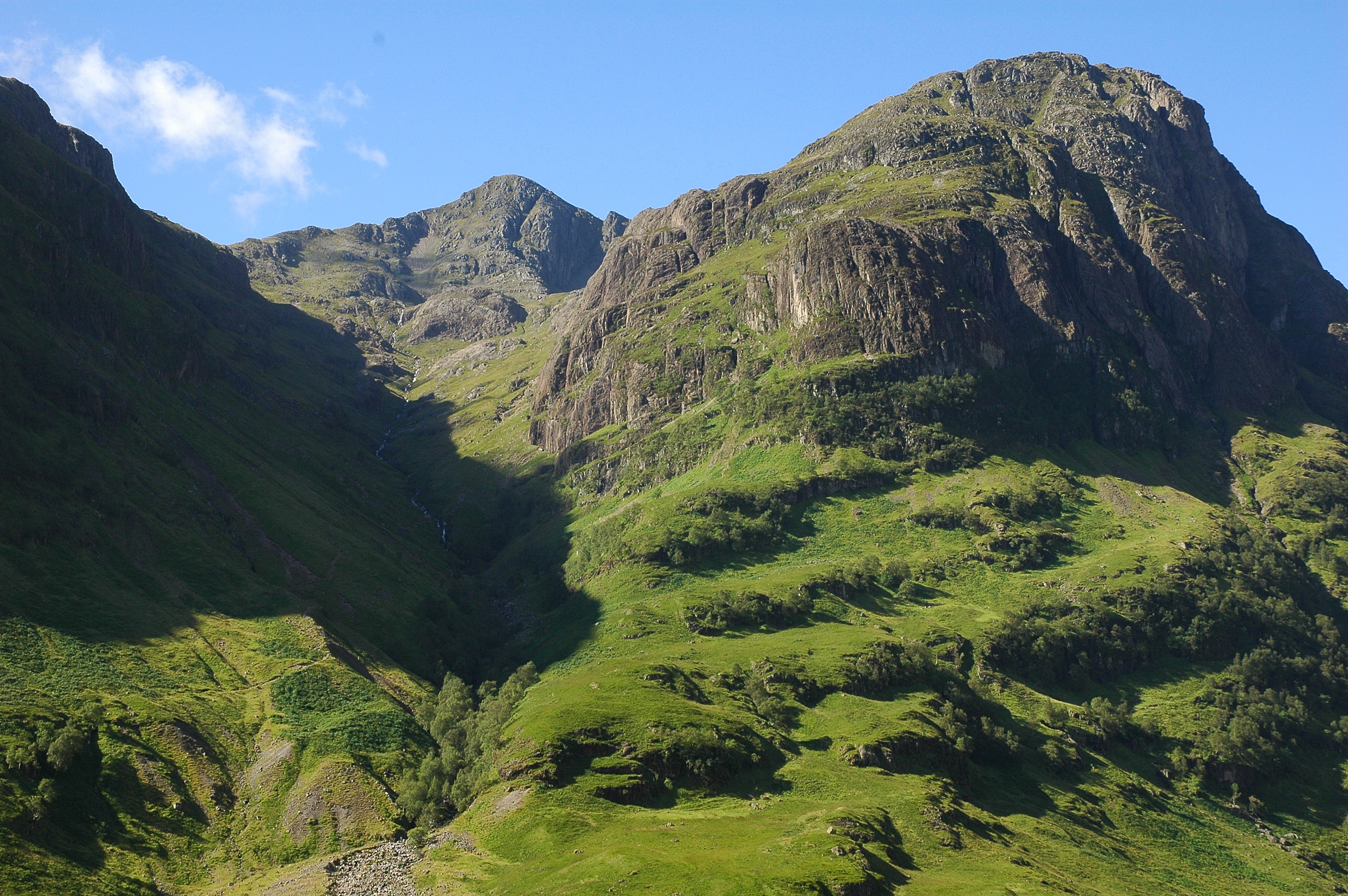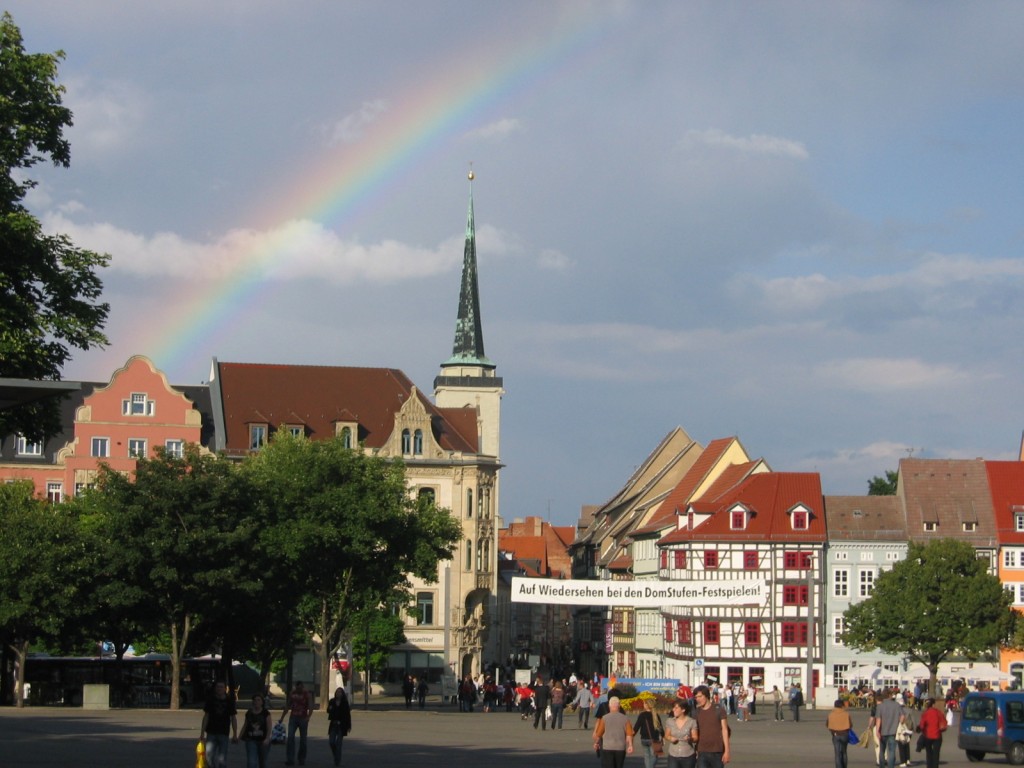What? There’s a huge elemental iron crystal hovering over my head? Yeah, right. Sure there is.
[The Atomium, Brussels, Belgium]
Category: Travel
The Painted Buddy Bears of Stuttgart
With all the stress going on in the world right now it seems like a good time for a change of pace. How about we look at some painted bears? United Buddy Bears, to be exact. A great number of these bears came together a few years ago in Stuttgart, Germany, and I was lucky enough to come across them. I gave you a glimpse of one of them a few days ago in “There’s a story to every picture.”
The “United Buddy Bears” are focused on the idea of “The Art of Tolerance.” For a limited time only the city of Stuttgart put on display bears from around the world. Each participating country was given a blank bear to paint any way they wanted. Then about 150 of them were placed around the fountain near the old palace (in the Schlossplatz). Each country tried to capture the essence – or sometimes the mystery – of their nation in how they painted the bears.
Let’s start off with an easy one.

Okay, the “Statue of Liberty bear” from the United States was pretty easy to guess. But how about this one:
Too easy? How about another easy one:
Okay, waaaay too easy, right? Let’s try one that might take a little more thinking. Look closely at the markings and the bit of a metaphor thrown in as a subtle point.
Now, how about a little scuba diving? This one may not be so easy to figure out, especially for North Americans.
One more because I found this one totally fascinating:
That’s enough for now. Feel free to guess which country each one represents in the comments.** (See below for answers. No cheating.)
David J. Kent is an avid traveler and the author of Lincoln: The Man Who Saved America, now available. His previous books include Tesla: The Wizard of Electricity and Edison: The Inventor of the Modern World (both Fall River Press). He has also written two e-books: Nikola Tesla: Renewable Energy Ahead of Its Time and Abraham Lincoln and Nikola Tesla: Connected by Fate.
Check out my Goodreads author page. While you’re at it, “Like” my Facebook author page for more updates!
Follow me by subscribing by email on the home page. Share with your friends using the buttons below.
**Answers
1. United States
2. Cuba
3. China
4. Croatia
5. Panama
6. El Salvador
There’s a story to every picture
Perhaps several stories. In any case, the story to the photo below will have to wait a few days. Be sure to bookmark the page and check back later…for the rest of the story.*
* Reference to radio program by Paul Harvey
Dublin, Ireland…Molly Malone…and a Man in a Donkey Head
Top o’ the mornin’ to ya. By now everyone should have recovered from St. Paddy’s day. Even President Obama downed a Guinness with his ancestral Irish cousin in Washington DC. The “effects” of celebrating old St. Patrick should have worn off by now (right?) and we’re all gearing up for going back to work in the morning.
Which gets me to the man in the donkey head. In Dublin. As in Ireland.
Whilst in Dublin I first set my eyes on sweet Molly Malone as she wheeled her wheel-barrow, through streets broad and narrow, crying “cockles and mussels, alive, alive, oh.”* At first she seemed sweet, saccharine even, as she stood there nicely bronzed in the sun selling shellfish by the seashore. We exchanged glances, smiles, and embarrassments before I moved on to check out the city. My hotel was nearby so the next day I couldn’t resist her allure and was drawn to check out her massive cockles. Only to find that she was being guarded by a man acting like an ass.
Or perhaps it was a donkey. Needless to say it was a rather unexpected event to see a man wearing a donkey head sitting by my dear Molly. Reading the Leopardstown Post racing news. Seriously, who would have expected to see that? Everyone knows that donkeys don’t like horse racing.
But here he was for all to see. The man with the donkey head didn’t speak (I suppose donkeys rarely do), nor did he perform anything other than simply sit there for the entire time we stood by to watch and to snap photos. Many others took photos as well and for a donkey-headed man he seemed quite patient to allow all of us to get our fill.
From here we moved on to explore Dublin. But I’ll always remember Molly Malone. And the man in the donkey head.
* From the song that inspired the legend that inspired the statue on Grafton Street, Dublin.
[Note that the Molly Malone statue has been moved from its original location on Grafton Street to a spot in front of St. Andrew’s Church.]
David J. Kent is the author of Tesla: The Wizard of Electricity and Edison: The Inventor of the Modern World (both Fall River Press). He has also written two e-books: Nikola Tesla: Renewable Energy Ahead of Its Time and Abraham Lincoln and Nikola Tesla: Connected by Fate. His next book, Lincoln: The Man Who Saved America, is scheduled for release in summer 2017.
Follow me by subscribing by email on the home page. And feel free to “Like” my Facebook author’s page and connect on LinkedIn. Share with your friends using the buttons below.
One Year After the Japan Earthquake and Tsunami – My Japan Travel
One year ago Japan experienced a horrendous earthquake that measured 9.0 on the Richter scale. Beyond the immediate structural damage from the quake and the reduction of tourist travel to Japan, parts of the country were devastated by a massive tsunami. In addition to the heart-wrenching videos of the massive waves destroying towns, the tsunami took out cooling systems at the Fukushima nuclear power plant, thus setting in motion three nuclear reactor meltdowns that forced the continued evacuation of a 12-mile area around the plant. Today Japan remembers the earthquake, the tsunami, and the 19,000 people who lost their lives.
At the same time, Japan is encouraging people to come back to visit. Most of the country is more or less back to normal. I visited Japan recently and found it to have the same quaint charm for which it is known, and vibrant in both its old traditions and new modernity.
Today I’ll highlight the tradition. As I toured the temples and the old gardens I was struck by the contrasts. While there were many young women wearing very short skirts and stockings, there were also quite a few women of the same age wearing traditional kimonos. Near the Kiyomizudera Temple in old Kyoto I encountered the following couple.
At first I thought they were simply actors dressed up to encourage tourists at the temple. Then I realized that there were many dressed traditionally who were tourists themselves.
That’s not to say that there weren’t people in traditional garb placed conveniently for tourist photos. After all, Japan wants travel dollars (and rubles, rupees and renminbis), and geishas are one of the things that tourists come to see. So wandering the narrow lane of Chawan-saka we encountered these two geishas.
And in homage to our hosts, a fellow traveler shows her appreciation.
There is much more to Japan of course and I’ll explore more aspects of my visit in future posts. So while Japan continues its recovery from the earthquake and tsunami of a year ago I bid you a temporary Sayonara.
David J. Kent is an avid science traveler and the author of Lincoln: The Man Who Saved America, now available. His previous books include Tesla: The Wizard of Electricity and Edison: The Inventor of the Modern World (both Fall River Press). He has also written two e-books: Nikola Tesla: Renewable Energy Ahead of Its Time and Abraham Lincoln and Nikola Tesla: Connected by Fate.
Check out my Goodreads author page. While you’re at it, “Like” my Facebook author page for more updates!
Follow me by subscribing by email on the home page. Share with your friends using the buttons below.
Elephants and Tigers and Gibbons – A Trek in Khao Yai Thailand
Asia has always fascinated me. A visit to Bangkok – before the recent flooding – was a view into a congested urban scene rivaling any of the large cities I have seen around the world. But there are relatively pristine areas as well. A short distance on the map of Thailand – only a two to three hour drive outside Bangkok toward the Cambodian border – is Khao Yai National Park. Khao Yai covers over 2000 square kilometers and includes protected forest, jungle, mountain and grassland habitat. There are also several mountains of around 1000 meters including the magnificent Khao Khieo (Green Hill).
The park is, in a word, amazing. It plays host to almost 2,500 plant species, 67 different kinds of mammals and over 300 species of birds. The abundant wildlife includes many endangered mammals such as elephants, gibbons, tigers, leopards and Malaysian sun bears. On a drive through the park on the main road you start to notice that many of the trees and man-made structures (sign posts, concrete road safety posts) are wrapped in barbed wire to protect them from the wild elephants roaming freely around the park. Still, many of the concrete posts have been pushed over by the elephants. No tigers or bears were observed on my visit, but some magnificently colored birds and packs of gibbons were frequently seen.
 The park is crisscrossed by hiking trails, ranging in length from one and a half to eight kilometers. A fairly short hike took me through the forest to a small stream. After having my photo taken on a rock overlooking what appeared to be a small precipice, I made a very steep hike down to the base of what turned out to be the tallest and most spectacular waterfall in the park. At about 250 feet high, Haew Narok falls is quite impressive (note in the photo below the spot I was standing on above is the flat rock on the top left).
The park is crisscrossed by hiking trails, ranging in length from one and a half to eight kilometers. A fairly short hike took me through the forest to a small stream. After having my photo taken on a rock overlooking what appeared to be a small precipice, I made a very steep hike down to the base of what turned out to be the tallest and most spectacular waterfall in the park. At about 250 feet high, Haew Narok falls is quite impressive (note in the photo below the spot I was standing on above is the flat rock on the top left).
My visit took place during the Thai winter (where 90°F is considered “cool”) and thus the water overflowing the falls was fairly timid. In contrast, park rangers were forced to build massive concrete pilings in the woods to keep elephants away during the rainy season when the water rages down the river and over the falls. Prior to building the pilings, 8 full grown elephants in one night alone were swept over the Haew Narok falls to their deaths.
Just outside the park, I was able to see the elephants close up. Heading for Pakchong Creek, I climbed aboard an adult female elephant for a nearly hour-long trek through the local forest. I rode for a while on a two-person carrier on the back of the elephant as my trusted mahout (driver) guided the elephant through the underbrush. But then it was my turn as the mahout dismounted and I moved down onto the neck of the elephant to guide us the rest of the way through creeks and forest.
From an environmental perspective, the trek through Khao Yai Park and the elephant ride was both heartwarming and disheartening. Tourism has now passed rice production as the biggest contributor to the economy. This increase in foreign visitors brings a broader appreciation for the ecological value of the country. But it also increases the physical demands on delicate ecosystems as more and more people descend on the park, much like the excessive tourist visits to Yellowstone and other American national parks have put a severe strain on the natural habitats, flora and fauna endemic to the regions. It is clear that Bangkok and Thailand must be aware of the environmental and human health ramifications of their continued growth.
Having said that – I can’t wait to go again.
The Artist at Midnight in Paris – It’s Oscar Night at the Academy Awards
Funny how two of the movies that are in the running for the Best Picture at the Academy Awards – “The Oscars” – are throw backs to times long since gone. The Artist is a silent film shot entirely in black-and-white as it explores George Valentin’s angst at the arrival of the “talkies.” Midnight in Paris is a modern day film, but is it? Suddenly we’re in 1920s Paris. Or are we? Is that Cole Porter? Hemingway? Carla Bruni? Wait – Carla Bruni?
Tonight’s Oscar gala reminded me of a photograph of mine. A photo of the artist in Paris. Perhaps an artist to be remembered some time in the future, but an artist nonetheless.
The girl seemed to be about 10 or 12 years old. She diligently worked, unperturbed by the tourists who stopped to photograph her openly – and perhaps critique her work privately. As the overcast sky threatened to send us all running for shelter, she began to flesh out Notre Dame de Paris while its imposing Gothic presence entranced all comers.
After five trips to Paris I feel as if I can play tour guide to its major attractions, and yet also feel that I’ve only begun to sense its culture. Notre Dame, the Eiffel Tower, the funicular railway ascending the hill to the magnificent Basilique du Sacré-Cœur (Sacred Heart), the Arc de Triomphe, and tour boats on the Seine – all are familiar to me. What is missing is the aura of the time when the wonderful artists of the past livened the streets and studios of Montmartre – Dali, Modigliani, Picasso, van Gogh, Camille Pissarro. Ah, the life they led.
Getting back to the Oscars, just tonight I watched Midnight in Paris, the modern day movie by Woody Allen that takes us back in time and regales us with the music of Cole Porter. In a way it felt like Forrest Gump for the artistically acquainted. I’m rooting for it to win Best Picture and will update this post after the announcements are made. The money seems to be on The Artist taking home the big prize though, at least according to all those folks who claim to know these things.
Either way, I’ll always have the artist in Paris, even if it wasn’t really midnight at the time.
Pap of Glen Coe – the Bonny of Loch Leven
Aye, the highlands of Scotland. You read about them, fancy yourself galloping across them with William Wallace, and perhaps spoil a good walk near them (i.e., play a round of golf in the Mark Twain sense). For me, I admired them up close.
To be honest, I can’t imagine a good walk spoiled in the highlands. On a summer day in 2005 I hopped into my Vauxhall Corsa, remembered to drive on the left, and headed north from where I was living in Edinburgh, Scotland. The drive itself was amazing, in part because the day started off a wee bit foggy – actually almost completely immersed in clouds – but blossomed at the most opportune moment.
And that moment was the Pap.
The Pap of Glen Coe is the mountain you see above to the left. It gets its name from the conical shape resembling a female breast (apparently the Scottish winters were quite dreary and imaginations were active). The Pap sits in the valley created by Glen Coe above the point where River Coe enters Loch Leven. Nearby is the intriguing Bidean nam Bian mountain ridges, including the famous Three Sisters of Glen Coe.
To say that these views were awe-inspiring is to engage in severe understatement. The glen has a distinctive U-shape, the result of glacial action during a past ice age. The area is what is left of an ancient supervolcano, long since gone extinct but imposing nonetheless.
I lingered in the Glen, admired the Pap, marveled at the mossy grass that seemed greener than naturally possible. My mind hiked high into the mountains, though my feet stayed closer to the narrow road. I took hundreds of photos that day, most of which are unfortunately lost due to the vagaries of my computer hard drive. But the memories remain with me as if it was yesterday.
Until next time, my bonny lass. Until next time.
Check out my Goodreads author page. While you’re at it, “Like” my Facebook author page for more updates!
David J. Kent is the author of Lincoln: The Man Who Saved America, now available. His previous books include Tesla: The Wizard of Electricity and Edison: The Inventor of the Modern World (both Fall River Press). He has also written two e-books: Nikola Tesla: Renewable Energy Ahead of Its Time and Abraham Lincoln and Nikola Tesla: Connected by Fate.
Follow me by subscribing by email on the home page. Share with your friends using the buttons below.
The Great Wall of China and Mount St. Helens – A note about the header photos
 I’ve been asked whether I took the photos you see in the header. The answer is yes.
I’ve been asked whether I took the photos you see in the header. The answer is yes.
As of this writing there are several photos that alternate in the header as you click through the various pages. I’ll write separate posts on each of these as this site develops – including showing the full photo (they had to be cropped to fit the header size). Click on the photo title to get to posts that have already been written. Here’s a quick synopsis:
The Great Wall of China: Taken on film in December 2000 on my first trip to Beijing, China. The day was freezing. Actually, below freezing. In fact, 5 degrees F. But the experience was something that I couldn’t get out of my mind even if I wanted to (which I don’t).
Mount St. Helens: A special access visit to the Park Service location in Washington State as part of a scientific conference. You can see where the side of the mountain blew out in 1980. The hot vapors you see are from new volcanic activity occurring while I was there in November 2004.
Palau de les Arts and L’hemisferic: Two of the amazing modern buildings in the ancient city of Valencia, Spain. Taken in 2008, they are part of the “City of Arts and Sciences” that also includes a world famous aquarium. As with the other photos, the original is even more impressive because there is a reflecting pool in the foreground.
Sunset in Fairfax: A spectacular sunset I encountered by chance one day upon arriving home from work. The photo is shot from my back deck and the moment was gone within a minute after taking it. The jet contrails add some intrigue to the reddest sky I have ever seen.
Stonehenge: The famous archeological site about two hours west of London. Seems they still can’t figure out for sure what its purpose was, but that doesn’t stop everyone from guessing – everything from a celestial clock to a sign that we once had alien visitors. It’s actually pretty cool for a bunch of big stones.
Gondolas: The photo was taken near Piazza San Marco – St. Mark’s Plaza – in Venice during a beautiful late summer day. The Church of San Giorgio Maggiore can be seen in the background.
El Teide: The third largest volcano in the world, El Teide sits on Tenerife, the largest island of the seven Canary Islands. This was taken Christmas day. At the base it was hot as the tropics; at the peak it was below freezing and snow covered.
Perito Moreno Glacier: Perito Moreno is in southern Patagonia, Argentina. I went there in February (their summer) to visit and travel with a long-time friend from my days in Bermuda. The site truly is breathtaking.
James Joyce: The photo that accompanies this post is a detail of the James Joyce statue taken in downtown Dublin, Ireland in 2010. This photo plays an important role in my “Adventures in Europe” photobook.
The book Stack: This photo shows a stack of my published books through September of 2016, including the two Fall River Press books, the two e-books, and the photo book. It will be replaced with each new book that joins the stack.
Adventures in Europe
Ah, Europe. Before the recent financial collapse, the kind of story book setting that I once read in, well, story books.
Spring to spring for the three years beginning in 2008 and ending in 2011 I had the good fortune to have been seconded to Brussels by my employer. Not the first time I had lived overseas – I had short periods previously living in Bermuda and in Scotland – but at three full years it was my longest opportunity of ex-pat living.
And live I did. Europe by its very proximity of nations offers a chance to experience a wide variety of languages, and cultures within a few mere hours. A one week driving tour, for example, took me into five different countries speaking four primary languages and through some of the oldest and charming cities in central Europe. More on those in later posts.
The purpose of this present post is to introduce a book of photography I published near the end of that three year European experience. Called “Adventures in Europe,” the book has 46 pages of photos I took at venues across the continent. Dedicated to my parents, it was my way of sharing my experiences with them and my extended family back home.
Click on the photo below to see the book.




